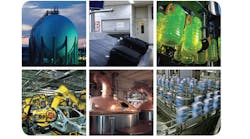Studio 5000 Software to Boost Collaborative Power
This article was originally published on ControlGlobal.com.
Collaboration is always crucial to innovation, improved productivity and adding value in all manufacturing applications—what evolves are the automation tools for making those tasks easier and helping users along their respective roads. Chief among these enabling forces is Rockwell Automation's Studio 5000 automation and engineering environment software, which has numerous functions for helping users design more capable machines and systems and is poised to add even more enhancements.
In fact, the coming release of Studio 5000 software is planned for later this year, but many of its new features were described in a super session this week at the RSTechED conference in Orlando, Fla. "The Connected Enterprise: The Collaborative Design Journey" was presented by Andrew Stump, design software manager for Rockwell Automation's Control and Visualization division.
"All products and solutions use design principles, so every developer seeks new ways to innovate, gain productivity and improve his or her business. However, each can achieve more through collaboration and simplifying processes by breaking them down into more approachable pieces," explained Stump. "Automation is no different, whether it includes designers, system integrators or engineers, but real-world collaboration isn't easy, especially as machines and applications evolve and grow more complex each day."
To aid users' productivity now and in the future, Stump reported that the new Studio 5000 software's main automation productivity enhancements will include:
- A new system logical organizer for better organizing software code. This new view will help users to find and manage their code layouts according to their individual application or systems.
- New modular automation capabilities with program parameters, which adds an object interface to software programs. This helps users write better modular code and share data more easily.
- Library management workflow changes, which make it easier for users to create hierarchies of code, manage them, then reuse them in a project or between projects. Simple wizard dialogues walk the user through the reuse steps.
- Code-merging capabilities that will allow users to bring together automation project files, compare and make changes, and then merge them into a single project.
"The dialog in the code-merging function will allow users to view both sides of a program, see what's different in each, pick the correct sections that they want and then merge them," said Stump.
New Cooperation Avenues
Though collaboration is still the goal, Stump reported these new levels of cooperation are far closer than the separate silos that mechanical engineers, electrical engineers and programmers used to occupy. "The advent of relay-based systems, PLCs and DCSs provided more flexibility in automated systems, but they also thrust mechanical and electrical engineers into much tighter collaboration, and this situation has been refined over the years as related technologies have improved," added Stump. "In the new millennium, these automations systems have evolved to gain even more productivity improvements, and this landscape is still ever-changing."
Because of this dynamic and changeable environment, Rockwell Automation is continually investigating how collaboration can help manufacturers, system integrators and machine builders design and build their automation systems. "Manufacturers establish projects, set specifications and decide who will build it," said Stump. "So modern collaboration means using electrical drawings, piping and instrumentation diagrams (P&IDs), and mechanical drawings. However, even though the paper drawings of the past have given way to CAD files and models, many users still pull their initial data and key it in manually. But how effective is this, especially when machines and production systems are evolving so fast?"
Partners Aid Collaboration Too
This is why Rockwell Automation is laboring mightily to enhance Studio 5000 software so it can better access and exchange digital data with related software packages, such as those offered by ePlan, Dassault Systèmes, MathWorks and other partners. For example, Studio 5000 software can use motion, load and inertia information from Dassault Systèmes, which enables users to test machine designs before any physical equipment is actually built. This can save huge amounts of capital that used to be spent on prototypes. Studio 5000 software and Dassault Systèmes interact via a standard called Function Mock-Up Interface (FMI).
"Virtual designs allow users to model the behavior of an entire machine or system, prove designs and then optimize them before construction at much lower cost," said Stump. "This also means the role of virtual designers is emerging, which requires some initial investment, but can have big payoffs."
Likewise, Stump reported that Rockwell Automation is working on standardizing its system data exchange interface, which will allow users to work on common machine and plant designs with standard P&IDs, instrumentation lists and automation systems, and even use these dynamic documents to help optimize regular, real-time operations. "Multiple people are usually involved in writing code, so it's crucial for them to be able to simplify and share their work using a standard, modular design approach," explained Stump. "Traditional, IT-based software developers use comprehensive design and version management systems, which can be very helpful, even though they can add a layer of complexity. We believe automation software development projects can adopt similar methods to add value."
This means tightly integrating Studio 5000 software with Rockwell Automation's FactoryTalk AssetCentre, which allows multiple users to check out common projects, work on them, check them back in and track changes as they're made. "Also, users can reuse code, software objects and libraries of objects to reduce development costs, time and risk. Rockwell Automation knows the value of supporting code reuse and modularization to simplify workflows, and that's why these new capabilities are part of Studio 5000 software," added Stump.




